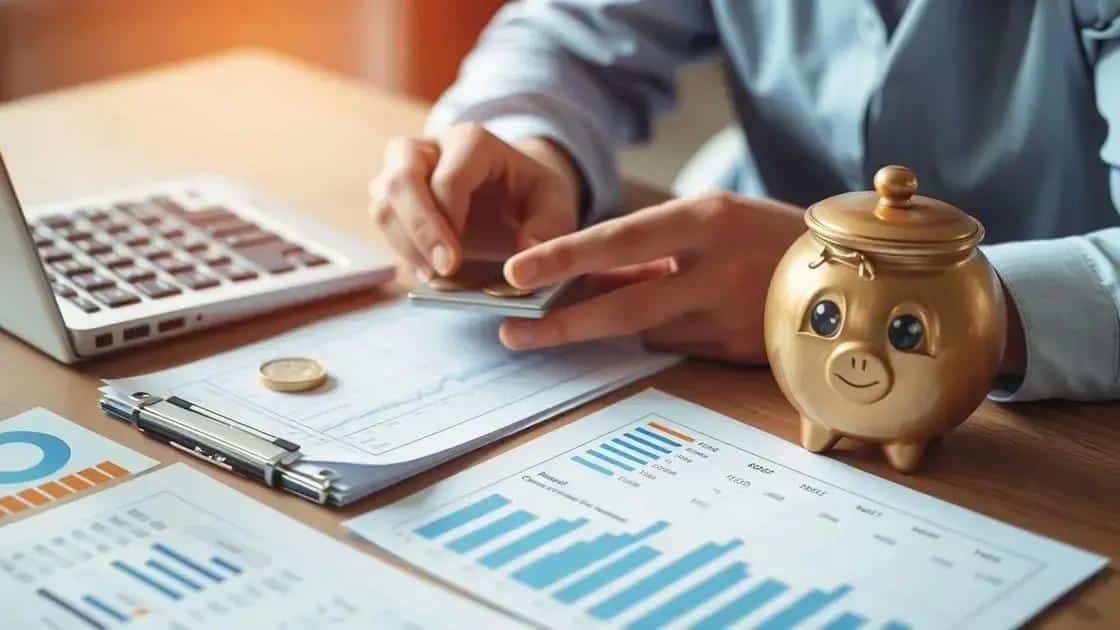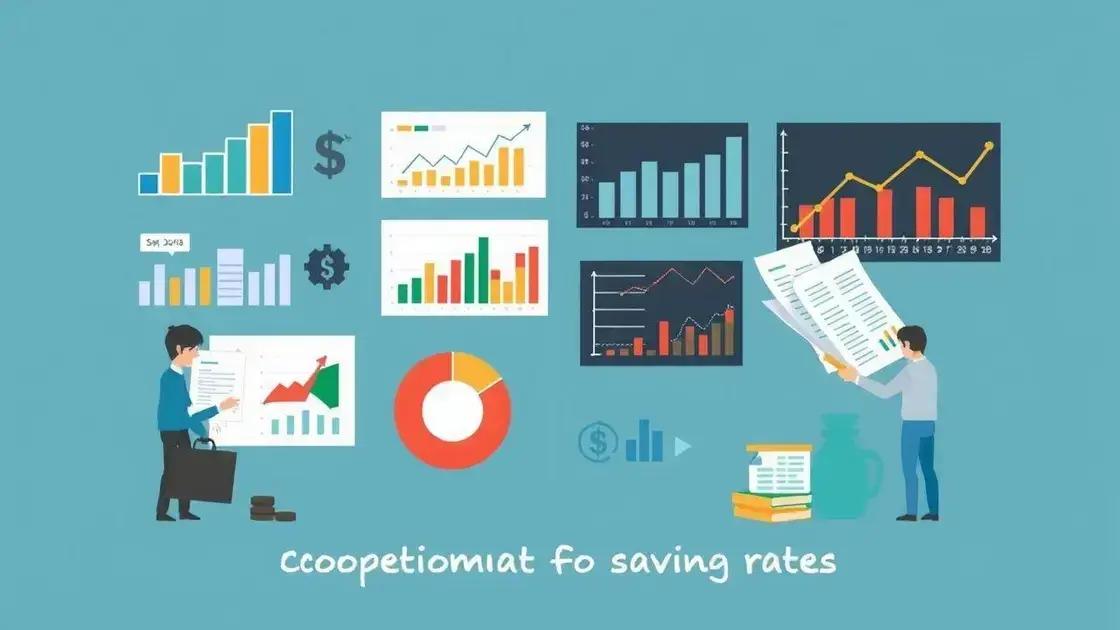U.S. personal saving rate April 2025 shows surprising increase

The U.S. personal saving rate increased in April 2025 due to economic uncertainties and consumer behavior changes, offering individuals benefits like financial security and improved credit health while influencing overall economic conditions.
The U.S. personal saving rate April 2025 increase has caught many by surprise, leading us to think about what’s driving these changes. Are consumers becoming more cautious or are new saving strategies at play? Let’s dive into this intriguing topic.
Understanding the U.S. personal saving rate
Understanding the U.S. personal saving rate is vital for grasping the financial health of American households. This key economic indicator reflects how much people save from their disposable income. Various factors influence this rate, with changes often signaling shifts in consumer behavior and economic conditions.
What is the U.S. Personal Saving Rate?
The U.S. personal saving rate represents the percentage of income that households save rather than spend. It provides insight into how individuals manage their finances and prepare for the future. Typically, a higher saving rate can indicate greater financial security among consumers.
Factors Influencing the Saving Rate
Several elements can affect the saving rate, including:
- Economic conditions, such as growth or recession
- Interest rates, which influence savings accounts
- Consumer confidence levels
- Government policies, like tax incentives for saving
Understanding these factors helps interpret changes in the saving rate over time. For example, when job stability is low, people might save more as a precaution. Alternatively, when job security is high, they may feel comfortable spending.
Additionally, cultural attitudes towards saving can vary widely. Some individuals prioritize saving for emergencies, while others may focus on spending for immediate gratification.
The Impact of the Saving Rate on the Economy
The U.S. personal saving rate plays a significant role in the overall economy. It influences economic growth, consumer spending patterns, and investment levels. A sudden increase in the saving rate might slow down growth as fewer dollars circulate through the economy.
However, higher savings can strengthen financial stability on a personal level. Individuals who save more may find themselves better equipped to handle emergencies and long-term financial goals. Therefore, monitoring this rate is crucial for both consumers and policymakers.
Understanding the U.S. personal saving rate in April 2025 helps us appreciate current economic trends and the behaviors of everyday Americans. By examining these patterns, we can better predict future changes in consumer finance and economic policies.
Factors contributing to the saving rate increase

Understanding the factors contributing to the saving rate increase in the U.S. offers insights into consumer behavior. Various elements interplay to influence how and why people save more during specific periods.
Economic Conditions
Economic circumstances can greatly affect the saving habits of individuals. During times of uncertainty, such as recessions, people often feel the need to save more as a safety net. A stable job market can encourage spending, but when job losses occur, the saving rate tends to rise.
Changes in Consumer Confidence
Consumer confidence plays a key role in savings. When confidence is high, people may feel secure in their financial situation and choose to spend more. Conversely, low confidence can lead to increased saving as individuals prepare for possible financial difficulties. Monitoring consumer sentiment can help predict changes in the saving rate.
Government Policies and Incentives
Government actions, including tax reforms and saving incentives, can also impact the personal saving rate. Programs that encourage saving, such as tax-deferred retirement accounts, can lead individuals to prioritize savings over spending.
- Increased tax deductions for retirement accounts
- Government stimulus checks during economic downturns
- Education on financial literacy and planning
These policies aim to support individuals in their saving efforts, which can lead to a notable increase in the saving rate. Moreover, external factors like inflation can compel people to save more, anticipating higher costs in the future.
Understanding these factors helps identify why the saving rate may experience spikes at different times. As consumers adapt to changing economic landscapes, their saving behaviors reflect broader financial trends.
Recognizing these influences provides valuable context for analyzing the U.S. personal saving rate and understanding its implications for the economy.
Implications for the economy
The implications of the increased saving rate for the economy are profound. When more individuals save, the flow of money changes, which can lead to various economic effects.
Impact on Consumer Spending
One of the most immediate effects of a higher saving rate is a potential decline in consumer spending. When people choose to save rather than spend, businesses may experience lower sales volumes. This can lead to slower revenue growth for companies, affecting their hiring and investment decisions.
Effects on Economic Growth
Increased savings can also impact overall economic growth. While saving is essential for personal financial security, if everyone saves more at once, it can create a paradox. This phenomenon, termed “the paradox of thrift,” suggests that when everyone saves excessively, it can slow down the economy. Reduced consumer spending can lead to lower demand for goods and services.
Investment and Interest Rates
A higher personal saving rate can influence interest rates as well. When more money is saved, it can lead to increased availability of funds for loans. This can result in lower interest rates over time, making borrowing cheaper. Lower interest rates can stimulate investment by businesses, potentially leading to economic growth in the long run.
- Increased capital for businesses to expand
- Potential for new startups to emerge
- Lower costs for personal loans and mortgages
However, it is essential to find a balance. If the saving rate remains high for an extended period, it can lead to economic stagnation. Policymakers must consider these dynamics and implement strategies to encourage responsible spending and saving.
The relationship between a higher saving rate and economic health is complex. Understanding these implications is crucial for both consumers and those involved in economic policymaking.
How consumers can benefit from saving more

Understanding how consumers can benefit from saving more is essential for financial health. Increasing the personal saving rate provides numerous advantages that can enhance a person’s quality of life.
Building Financial Security
One major benefit is the development of financial security. When consumers save regularly, they create a safety net for unexpected expenses. This could include emergency medical bills, car repairs, or sudden job loss. A solid savings account helps individuals feel more stable and less stressed in challenging situations.
Achieving Financial Goals
Another advantage of saving is the ability to reach long-term financial goals. Whether buying a home, funding education, or planning for retirement, savings play a crucial role. Setting aside money each month helps ensure that individuals have the necessary funds to achieve these aspirations. By working towards goals, consumers may feel a sense of accomplishment and motivation to continue saving.
Improving Credit Health
Having savings can also improve credit health. When individuals save up for purchases instead of relying on credit cards, they avoid accumulating debt. This practice leads to lower interest costs and higher credit scores. A strong credit profile opens up opportunities for better loan terms, lower interest rates, and increased borrowing power.
- Less reliance on credit cards
- Improved loan terms and conditions
- Increased financial independence
Additionally, saving more allows consumers to invest in themselves. Whether through further education or starting a business, having capital available can lead to significant personal growth. This investment can yield high returns in the future.
In summary, consumers can gain numerous benefits from saving more, including enhanced financial security, the ability to achieve goals, improved credit health, and opportunities for personal investment. Embracing a saving mindset cultivates a pathway toward a more secure financial future.
In conclusion, the recent increase in the U.S. personal saving rate has significant implications for consumers and the economy alike. By saving more, individuals can build greater financial security, work towards their long-term goals, and improve their overall financial health. Understanding how to balance saving and spending is essential for achieving a stable and prosperous future. With a proactive approach to saving, consumers can navigate economic fluctuations and invest in their well-being.
FAQ – Frequently Asked Questions about the U.S. Personal Saving Rate
What is the U.S. personal saving rate?
The U.S. personal saving rate is the percentage of people’s disposable income that they save rather than spend. It reflects consumer behavior and financial health.
Why has the saving rate increased recently?
The saving rate has increased due to factors like economic uncertainty, changes in consumer confidence, and government incentives that encourage saving.
How can saving more benefit consumers?
Saving more can provide financial security, help achieve long-term goals, improve credit health, and create opportunities for personal investment.
What impact does a higher saving rate have on the economy?
A higher saving rate can lead to decreased consumer spending, which might slow economic growth. However, it can also improve financial stability and investment opportunities.





